Charities, NGOs, Aid Programs and Volunteers Work Together to Meet Kenyan Drinking-water Needs
Published on by Amleto Pucci, Active Volunteer; Mostly Retired in Non Profit
How Charities, NGOs, Aid Organizations, and Volunteers work together to help Kenyans meet their fresh drinking-water needs.
by Amleto A. Pucci, Jr.
Needs Grow Rapidly in Urban Areas: I began work as a volunteer for a water project in Kenya and went there in March 2017. My purpose was to help reengineer the water supply at the mission compound in the town of Kasarani, located about 30 km north of Nairobi city. The compound is a religious community run by the Little Sisters of St. Francis (LSOSF) and an integral center for services to the poor and needy. From their compound they run a 200-bed regional hospital, a nursing school, educate from pre-school thorough secondary-level, and run a day-care center. They also have a community health-care program and serve nearly 60,000-outpatients a year. The 13-acre compound is surrounded by densely populated semi-slums that were built up around its perimeter over the past forty years since the mission was started.
The rapid population growth near the mission happened for several reasons: migration trends from rural areas to urban centers and towns; flight from regional wars in South Sudan, Somalia, and Congo; refuge from ravages of East African droughts and starvation. As a result, the water resources and infrastructure of the county water department do not meet the large water needs around the mission. The water department cuts off water in this part of the county four days a week. This forces everyone to find means to store water for use later or find other sources. The LSOSF Mission had an old unreliable well and found ways to conserve water, however, in these measures were inadequate for the mission to provide its services to the community. So, each week they purchased 7-or8 tanker-trucks of freshwater.
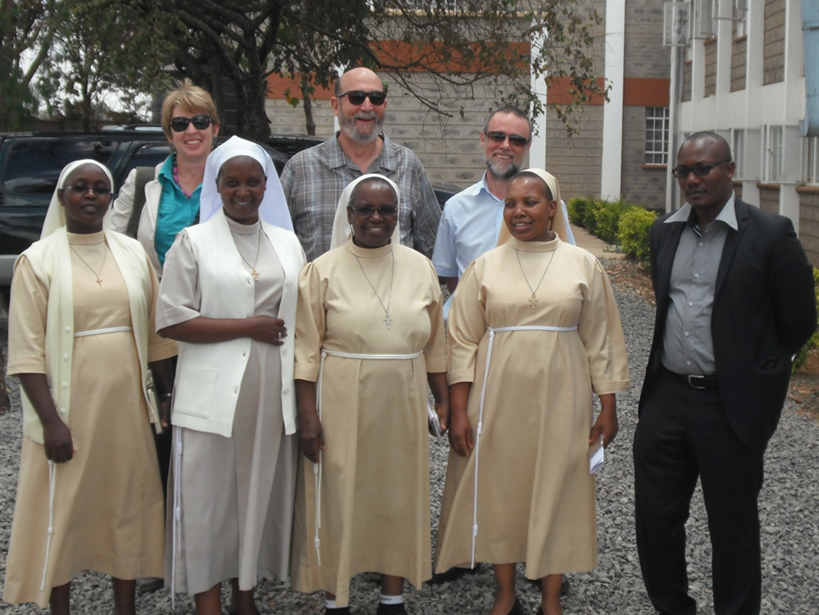
Water Project Kickoff Meeting, Little Sisters of St. Francis Mission, Kasarani, Kenya, March 2017. (L-R) row 1-Srs. Esther, Lilia, Redempta, and Sr. Supr. Alice, Lugard Ogara, KIWASH. row 2-Joyce Tannian, WILK, Amleto Pucci, volunteer & author, Tim Grayling, KIWASH Contractor.
Much of the water project work was finished in 2018 and the water and treatment plant were dedicated but there is more to be done. The plan is that by 2021 the LSOSF will also supplement the county water department and they will become a water supplier (at-cost) for about 2,500 people in the surrounding neighborhoods at two or more Kiosk Water Distribution locations. This work and a project add-on to help meet large energy demands for the growing operation are ongoing.
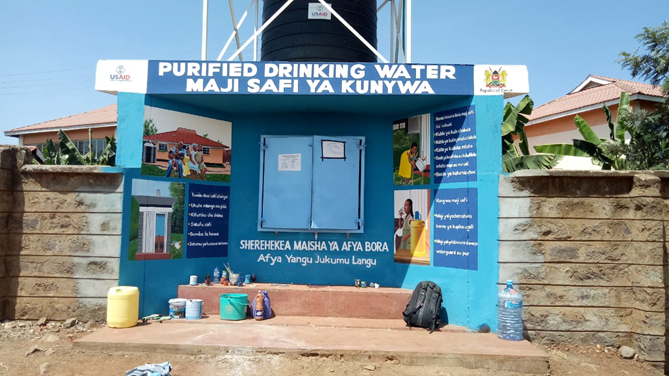
Sketch of what a one of the Kiosk Water Distribution locations will look like along the perimeter of the Mission Compound for the Little Sisters of St. Francis Kasarani, Kenya. “ Maji Safi Ya Kunywa” is Swahili for “Fresh Water to Drink.
An NGO Helps the Masai Tribe find Water for their Village:
In preparation for that 2017 trip I reached out to American water resources organizations that were active on water projects in Kenya. I found an especially willing and helpful NGO, “Water is Life Kenya” (WILK) ( https://waterislifekenya.com/ ), based in Newark, Delaware. They briefed me on work adjustments in the local culture and helped me prepare for my trip. They also agreed to assist me by liaising with the project staff at the Kasarani compound for me. They sent me some very helpful data which made my preliminary plan more effective. Because of them I was able to research the local water-resources regulations which I needed for the water project.
After two weeks on site at Kasarani, I arranged a work break and made plans to visit WILK staff at their current water project site. I was driven to join a WILK team south of Nairobi then we travelled together from there to the village of Oloitokitok, located in the south Kenya, just north of Tanzania. The morning after I arrived, I took a long walk to a height in an open area of farmsteads outside the town. There I had a clear view of cloud topped Mt. Kilimanjaro and its mostly melted glaciers.
The WILK mission is to help the Masai people find their way into the 21 st Century and do it in a manner that they maintain their integrity as an indigenous people. A most pressing concern for them as more land becomes cultivated and made private is finding ample, potable water for themselves and their livestock. Masai are traditionally nomadic herders, moving between grazing areas with access to enough water. Joyce Tannian, who founded WILK, begin each project by identifying villages where there is potential for a tribe to transition to a more permanent community locus and where there is a lack of a dependable, potable water source. I got to see how they follow their mission in the village of Kuku.
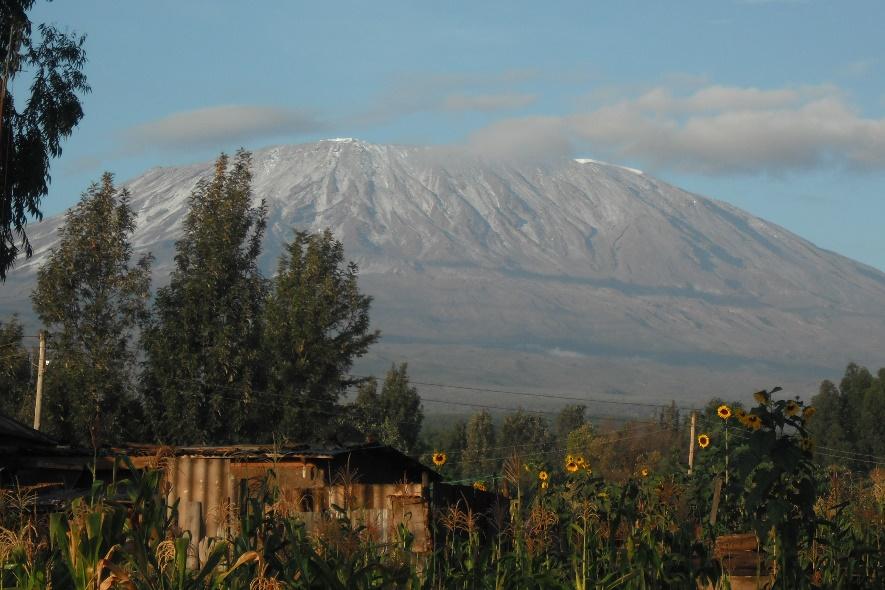
Mt. Kilamanjaro , Tanzania viewed from the Oliotokitok, Kenya
A Village Decides
We drove for about two hours from Oliotokitok for a tribal meeting in Kuku village. After a short while our SUV left the main north-south regional road and we drove east on a dirt road for two hours. Our team was led by Joyce Tannian, the WILK Founder and Director, and her assistant Veronicah who arranged the meeting, and Phillip, the WILK Masai spokesperson. Stephen drove and I discussed with the WILK team about how far along the Kuku villagers were introduced to the water project proposal. We also talked about Veronicah’s work for WILK educating farmers on new methods and how to make farms more profitable and sustaining.
As we drove, we passed Masai giraffes near the roadside eating from trees and could find others blended in densely covered areas. Single giraffes were probably adult males, while the small groups we saw were likely females and young giraffes. There are three giraffe sub-species in Kenya, aside the Masai giraffe there is the Reticulated and Rothchild which were not in this area. As magnificent as they were, they are not in the Kenyan “Big Five”--elephant, lion, leopard, rhino, and wildebeest. There were also many kinds of antelopes, warthogs in bunches, and baboons in clusters along the way.
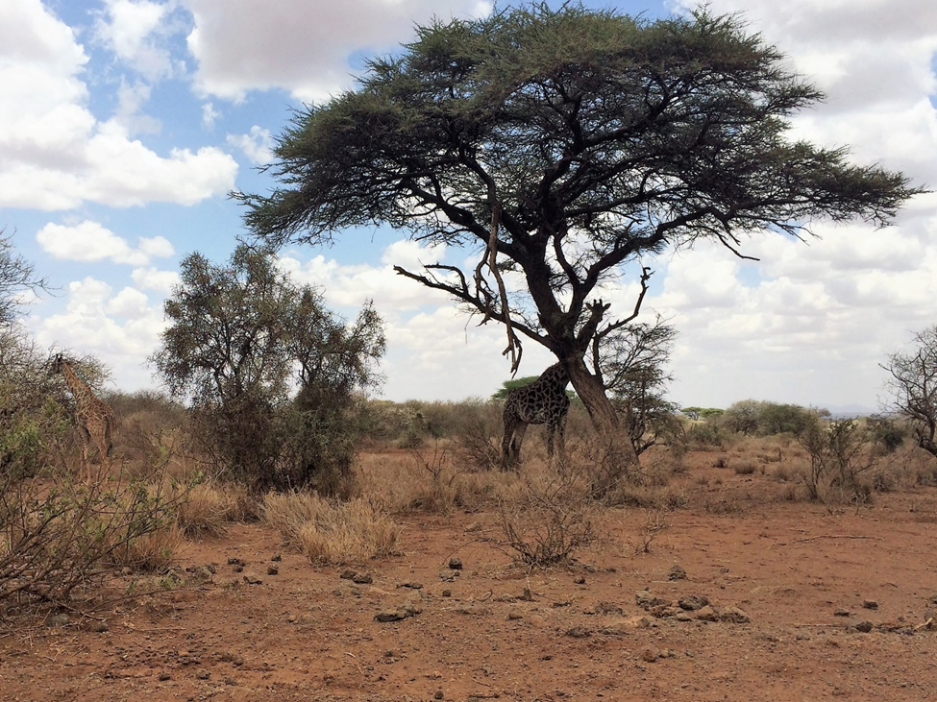
Two giraffes browsing along road to Kuku. Larger one beneath tree . Find the other giraffe in the picture.
We were stopped at a check-point and warned by a soldier that bandits recently killed some tourists further down the road where it approached another national park. Continuing ahead we passed a few farmstead locations before arriving in a small valley with several simply-built farmsteads and farm fields. As we got closer to this area there was a large herd of tended goats that we slowly drove through.
We were a bit late for the planned tribal meeting at Kuku village, which was a spread-out cluster of farmsteads across the valley. Stephen turned off the road and drove alongside a farm-field to where villagers were loosely assembled. We left the SUV and were led with everyone up a path to a hill top. On the crest were two large shade trees, and scrub brush, and large boulders that overlooked a few farms in the valley.
A tribal leader led the about twenty men to the shade of the tree higher on the hillside where mostly sat or stood together. Joyce Tannian and Veronicah were the only women allowed with the male group and by custom they followed the tribal men. Philip, Stephen, and I also sat in this group. There were more tribal women, but they mostly sat beneath the nearby tree, close together in the shade and within easy earshot.
Joyce and the WILK Directors are sensitive about how their project work brings change into their village. They want to make sure that villagers understand that a water well is a permanent water supply that ties the Masai to that location. The tribal members must each consider for themselves the benefit of a water well against changes in some nomadic elements of their culture. So, WILK works to create conversations in large group settings and communicate closely with leaders. It seemed to me that WILK staff had already established a good rapport with the tribal leaders and succeeded at conducting it in the tribal custom.
A tribal leader spoke for a while and began the meeting. He was by Philip whose job was to present water-well project plan, explain how it would be done, and to make clear it only would happen if they wanted it. Being a Masai, Philip he spoke easily and colloquially as he stood in the center of the men. Looking back on my take away he basically introduced the notion of a “village water utility,” and did it with panache and good-humor over a couple of hours.
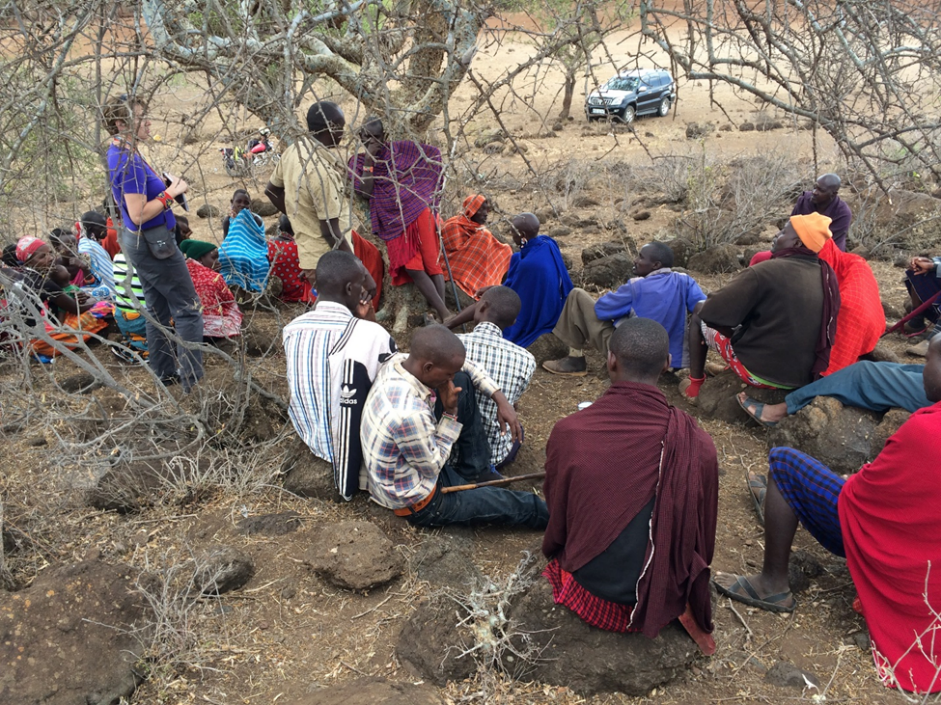
Philip, the WILK spokesman (center, tan shirt), addresses Masai tribe of Kuku village, Kenya on the proposed water well project. Joyce Tannian, WILK, in purple top, stands to left. The women sit apart and beyond the tree.
A couple other men spoke while Philip led the discussion. They took turns. If a man was going to say something, he waited for the person speaking to finish, and then either rose and spoke, or moved close to the tree then spoke. I seemed to think there might an unease about how a well works and so I also spoke about this for a few minutes.
Looking back, it probably didn’t hurt but Joyce told me most of what I said was lost in translation.
WILK also approaches their water projects in a way so that the local Masai villagers must “buy-in” before any site construction begins. For Mesai to raise capital means they must sell some of their wealth, tantamount to livestock. A majority of the tribal families must agree to sign and take part in owning the water-well. WILK raises nearly all the capital for the projects and the tribal villagers nun and maintain them knowing that WILK is their partner and guide.
Late into the hilltop meeting, a very old man next to me turned away the center of attention and made hand-gestures towards the direction of the mid-afternoon sun. Within a few minutes from the direction the man had been gesturing was an approaching sand-storm. It blew suddenly through the valley and across the top of the hill. There were nor reactions other than turning backs to the wind, covering up heads and faces with tribal clothing blankets, and waiting for a quarter hour while the storm passed.
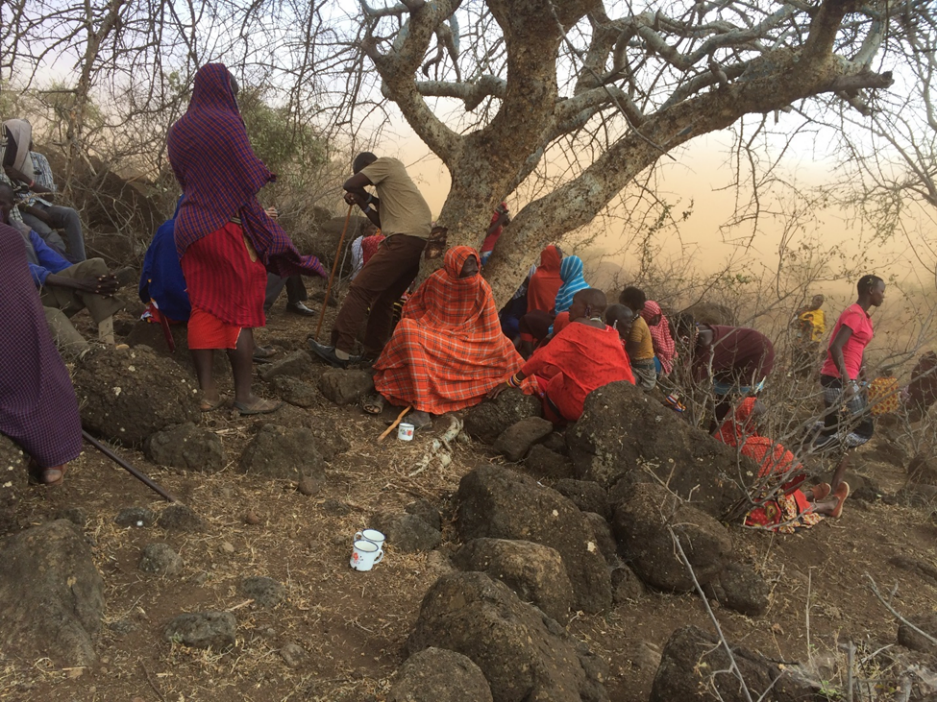
Sandstorm interrupts the discussion of the proposed WILK Water Well Project meeting with the Masai tribe in Kuku village.
Afterwards a few women left but before the meeting ended the Chief’s wife, a very old woman, approached the edge of the male group and forcefully addressed them. Later I learned that she said how much all the women wanted to have this water-well project and that all their lives would be better. After that another woman made her way through the male group and gifted me with a beaded necklace for my visit to Kuku.
The tribe left the hill. There was no pronouncement or final decision then or soon after, but information was on the way throughout the tribe about the potential for an ample and healthful water supply. WILK had told them about how this modern way would allow them to manage drought and reduce suffering from water-borne diseases. They knew there was a way to minimize the consuming daily chore of finding water for themselves, their livestock, and gardens. Joyce, Phillip, and Veronicah all thought the meeting went well and I learned by late 2017 there were enough families signed up to complete plans for the project. The Kuku villagers decided the benefits from a water-well was acceptable in their village.
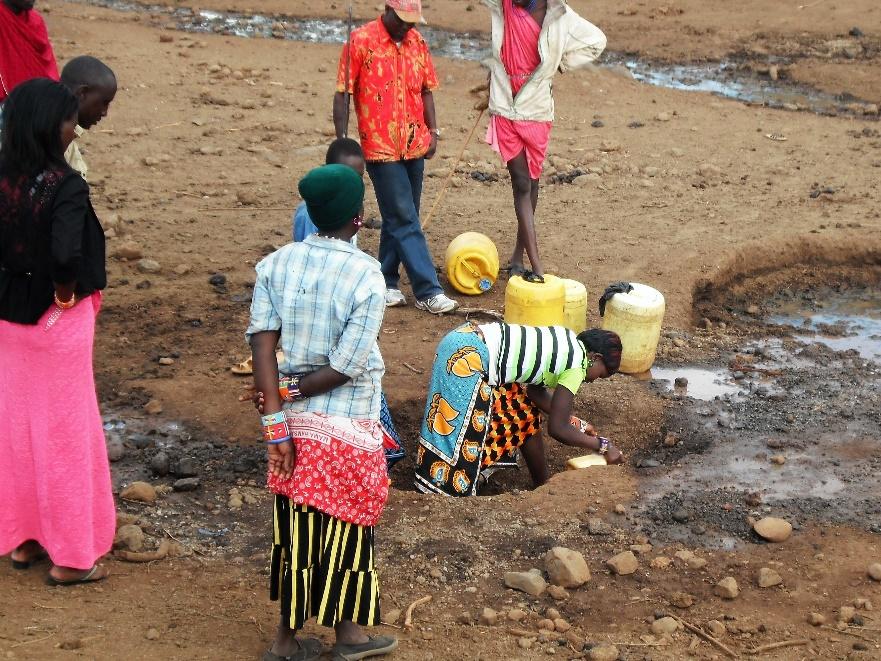
A Woman scooping water dug from a hollow beneath a dry streambed , Kuku, Kenya.
Good News:
In October 2018 the Kuku borehole project was completed. Learn more about by searching online for Water Is Life Kenya , then going to the Kuku project link. So far in the ten years, WILK has done their work, more than a dozen projects near Amboseli National Park in south-central Kenya have been completed for Masai tribal villages.
Media
Taxonomy
- Rural Water Supply & Sanitation
- Community Supply
- Rural Area Water Supply
- Urban Water Supply
- Water Supply Protection
1 Comment
-
contact amletopucci@ptd.net
1 Comment reply
-
Thanks Trudi for helping to make this kind of work get coverage. It may help gain support. Yours truly, Amleto
-